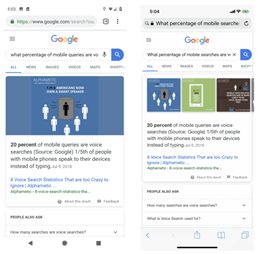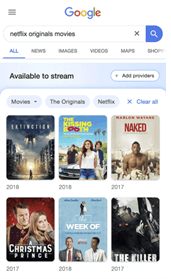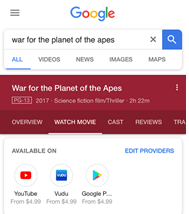Welcome to the first Technical Roundup of 2019, where you will find a list of important updates and news for the major search engines, Google and Bing.
Web Development
Google Publishes Guide to Optimise Website Speed with Chrome DevTools
Early in January Google technical writer Kayce Basques published a resourceful guide that teaches site owners how to use Chrome DevTools to improve page load times.
In a series of over 50 well-documented and easy to follow steps, the guide is aimed at users without pre-existing knowledge of load performance. Although, Kayce does note that knowledge of basic web development (for which there’s also a class available) and familiarity with DevTools is something of a prerequisite.
Useful tips include making an initial audit to understand page load speeds, enabling text compression, resizing images, and eliminating render blocking resources.
The guide also features a video that you can watch as you follow each step using the example source code provided by Google:
Page load time is a critical factor on how people interact with websites, as well as being an important aspect of technical SEO. This is a very actionable resource for improving load times for developers.
Discussion Arises Over Why Some Users Prefer Apps to Websites
While in the research phase of creating her next presentation, Aledya Solis asked her twitter followers why people might choose to download an app instead of using its corresponding website.
In response, SEO Jon Henshaw replied, stating that: “It’s always about UX. If the UX is better on a native app, I’ll download and use the app instead. I’ll only use a website if it’s for reading or accomplishing simple tasks.”
Accompanying his tweet was also a useful article that he had written, which discussed whether or not a business should convert its site to a web app.
If you’re considering porting a website across to PWA, Jon’s article offers a rounded view of both the benefits and concerns surrounding a switch, as well as going into detail about when the best time could be to do so.
Search Console’s URL Inspection Tool Adds HTTP Response, Page Resources, JS Logs, and Rendered Screenshot
On 16 January, the official Google Webmasters account on Twitter announced that a range of new additions had been added to Search Console’s URL Inspection Tool.
Webmasters can access the new features in the new Google Search Console by clicking on the URL Inspection Tool. From there, enter a URL to conduct a live test so that you can access and view the new features, including HTTP response codes and blocked resources.
Google will also present your JavaScript log and site owners will be able to view how the search engine renders the page.
Acclimatise yourself to the new features and UI. You may already be getting this data from another source or tool, but it’s worth checking to see whether the new features can be incorporated into your monitoring process.
Index Coverage Report Expanded
Just a day after additions were made to the URL Inspection Tool, Jamie Alberico tweeted to report that the Index Coverage Report had been expanded.
The additions now include:
- Duplicate non-HTML page
- Blocked by page removal tool
- Blocked due to unauthorised request (401)
- Page removed because of legal complaint
- Queued for crawling
- Submitted URL dropped
If you were previously receiving inadequate information from GSC as to why a particular URL isn’t indexed, check again to see if the expanded functionality helps categorise the kind of issue you’re experiencing.
Find out how to use Search Console to inspect URLs on accounts you don’t have access to
On 23 January Oliver Mason wrote about an experiment whereby a webmaster could use Search Console to inspect the URLs of profiles that they have not been verified on.
Using a new feature within the URL Inspection Tool, which shows how Google renders JavaScript, a webmaster can bypass restrictions on other non-verified profiles with the following steps:
- Use a verified Search Console profile to any site available.
- Set up a redirect from the verified website to a URL on the non-verified website.
- Inspect the redirected URL in the Search Console.
- Use the “Test Live URL” function.
To view more than a preview of the Rendered Source, you only need to:
- Copy the HTML from the page that you tested
- Inspect the element in Chrome and edit as HTML
- Overwrite this by pasting what was rendered by Google’s User Agent
- Press enter and view the rendered page.
Two limitations are known:
- It’s not possible to edit the User-Agent. However, this will most likely be GoogleBot Smartphone for all mobile-first enabled sites.
- If the destination is blocked in the target site’s Robots.txt, this won’t work.
Offensive strategy: It would be possible to check competitor web pages to understand how Google renders their source code. However, the information does not contain anything highly sensitive or actionable.
Defensive strategy: It’s not currently possible to block competitors from looking at this information.
Google publishes Guide for Google News
On 17 January Google published “How to Succeed in Google News”, offering publications a variety of guidelines and tips for 2019. Some of the major takeaways include:
- Presenting clear headlines, including within the HTML title tag.
- Providing accurate times and dates, as clarified in the Google Guidelines.
- Using structured data, including datePublished and dateModified schema.
- Don’t artificially freshen a story (changing the date and time without adding new information).
- Avoid duplicate and scraped content and block content that is rewritten.
- Be transparent to visitors and do not try to deceive them.
Most of the above are relatively well-known guidelines that have been published before. We must consider why Google published the article, as some suggest that Google could be preparing penalise news sites that do not follow its guidelines in the future.
On the same day, Danny Sullivan tweeted, saying that: “This is a reminder that these are important guidelines to follow, which is an important part of helping publishers in Google News with these issues. We do take action on violations.”
Google has been known to make algorithmic changes in the past after posting such guidelines however.
It’s hard to predict whether Google will punish publishers in Google News for not following its guidelines in the future. Edging on the side of caution, having an early adoption strategy in place could be a safer position. Familiarise yourself with its guidelines to ensure that you are not penalised.
John Mueller Previews Image Search Changes at Meetup
On 24 January John Mueller hosted a meetup in New York and discussed some incoming changes for Image Search and the closing down of the old Search Console.
Regarding images, Mueller said that Image Search was going to have a more significant and different presence in 2019.
According to Barry Schwartz, John said that searchers might start using image search to “accomplish tasks, complete goals, buy online, learn something new and more.”
He also stated that the changing behaviour will mean that SEOs and webmasters will have to think differently about how they optimise images.
Regarding the old Search Console, which Google is “sunsetting”, Mueller stated that even more reports are to be dropped, including the crawl error report.
It is expected that the old version is to be discontinued entirely in March.
Image optimisation can often be overlooked, but this is a factor that is becoming increasingly important and perhaps even a strong competitor to the likes of Pinterest. If you’re not optimising your images, now may be a good time to start.
Google Pushes Focus to New Search Console
Writing on 25 January, Google published an article regarding upcoming changes in the new Search Console, as well as some that have already been implemented:
Crawl errors in the new Index Coverage report
Google stated that it is going to change its focus on “issues and patterns” used for site indexing so that webmasters can locate and fix issues much quicker.
As a result, the search engine is going to remove the old Crawl Errors report (as discussed by Mueller), for desktop, smartphone, and site-wide errors.
Additionally, the old crawl errors API is to be depreciated, although there isn’t a replacement for it yet. Users will be directly informed of this change.
Sitemaps data in Index Coverage
Since the new sitemaps report has most of the old report’s functionality, the latter is going to get turned off.
Google says that it is “aiming to bring the rest of the information — specifically for images & video – to the new reports over time.”
The article also says that to track URLs submitted in sitemap files, the Index Coverage report can be used for filtering sitemap files, which makes it easier to focus on essential URLs.
Improvements already live and being used
The article also discusses a range of new improvements, such as the ability to use the URL inspection tool to “fetch as Google”, the fact that user management can now be located within settings, and that several new structured data reports are available in the console.
Dropped features
The article also discusses some of the features that Google is to drop from the Search Console, including:
- HTML suggestions
- Property Sets
- Android Apps
- Blocked Resources
As Google transitions from the old Search Console, older features will be deprecated in favour of new ones. Ensure your business is aware of Google Search Console updates in order to capitalise on new insights and functionality.
A range of Updates Added to Google Assistant
A variety of updates were added to Google Assistant in January, leading some to question if the app will be built around transactions, rather than through advertising.
Some of the major updates include:
Foreign Language Translation
Announced and tested out among the public at CES, Google said that it was rolling out foreign language translation for Google Home devices and that it was to rollout Google Assistant integration into Maps.
The new function will support more than 25 languages and will also be available on Google Assistant supported third-party smart displays. Statements can be read out to users, as well as appearing onscreen.
Airline Check-ins and Hotel booking Integration
The Assistant now allows for select airline check-ins and hotel bookings.
For the moment the booking capability is only available on smartphones, but Google has stated that it is currently working with multiple hotel chains and booking companies so that it can expand the feature.
The search engine has admitted being in talks with Choice Hotels, AccorHotels, InterContinental Hotels Group, Priceline, Expedia, Mirai, and Travelclick.
It also said that this was “just the first step” in funnelling hotel bookings through the Assistant.
Regarding airline check-ins, Google has also said that it is in talks with more airlines so that people can check in using the Assistant.
Assistant Introduced to Google Maps
It was announced last year that Google Assistant would be introduced to Maps, which means that users can now send texts, play podcasts, or listen to music through the app.
In the Android version, there will also be additional capabilities such as sending messages through third-party apps like WhatsApp or Facebook Messenger.
The updates suggest that Google is working to ensure that the Assistant becomes a transactional platform. For marketers, this should be of significance as Assistant grows in popularity. Ensure structured data markup is clear and correct so that the correct information is offered to users.
Mueller Reminds Webmasters not to put Organisational Schema on Every Webpage
During a Google Webmaster Central hangout, John Mueller explained that organisational markup should not feature on every page on a website, and that in most cases, the best place for it will be on the contact page.
Review your structured data and ensure that organisational data isn’t found on every page. If the website only contains one business, the contact page can often be a good place for it. Watch the clip from the hangout for further clarification.
Google Creating Featured Snippets from PDFs
On 16 January Kevin Indig tweeted, reporting that he had witnessed Google providing Featured Snippet results from PDFs.
This is quite significant, as we now know that Google can utilise PDFs for featured snippets, which are lucrative for high levels of traffic and are sometimes referred to as “position zero”.
If you have any PDFs on your site, such as guides, learning texts, or product manuals, ensure that they can be found by Googlebot and consider optimising them for the opportunity to get featured within a snippet.
Voice Input and Spoken Results Added to Mobile Web Search
On 28 January it was reported that Google had added a microphone symbol to the Google.com search field on Android phones; enabling its Voice Search technology. The below image shows the difference between Android and iPhone chrome apps:

Android users can now have spoken responses, which could be useful for when someone is asking a question when they are busy, such as “what is the time?”
It’s unclear for the moment whether the technology is Google Assistant in action.
The internet is becoming increasingly focused on mobile technology, and Voice Search is an essential aspect of that. Read through Google’s Voice Search guidelines to ensure that you’re abiding by best practices.
Google Tests new Interface for Movie and TV Streaming Options
Two days into the new year, Valetin Pletzer tweeted that he and many others had witnessed Google testing new layouts for movies and television shows in the SERPs.
Featuring a variety of streaming providers and options, you can see what the layout looks like on mobile, below:

This isn’t the first time that Google has toyed with the idea however, as it also tested the feature out in 2017, which looked like this:

With more people turning to and signing up for streaming services to watch their favourite shows and movies, it makes sense that Google would integrate these into its service features, especially as the search engine owns YouTube.
Streaming providers should investigate how and why Google chooses to show certain platforms, shows, or films in this feature on the off chance that the change becomes permanent.
Bing
Site owners Able to Submit 10,000 URLs a day in Webmaster Tools
Bing announced on 31 January that it is now allowing webmasters to submit up to 10,000 URLs per day into its Webmaster Tools, which is a vast upgrade considering that this used to be limited to just 10 per day and a maximum of 50 per month.
Log in to Bing’s Webmaster Tools and access the Submit URLs feature within the “Configure My Site” section.
Bing Admits it Ignores Default Robots Directives if There is a Bingbot Section
On 2 January Frédéric Dubut, a member of Bing’s search team, tweeted to say that if a site creates a specific robots.txt directive for Bingbot, then it will only look at that specific section:
When creating a robots.txt directive for Bingbot, ensure to copy all directives from the default to the Bingbot section you want the search engine to comply with.
Bing Maps Gets Built out With Locations in Mind
Writing on 28 January, Bing announced that its team had added a whole range of new features for Bing Maps, including three new REST APIs.
Location Recognition API
With this API, people can get information about points of interest near them, including businesses such as shops, restaurants, and hotels.
The API also helps answer user questions such as, “what neighbourhood am I in?” or even, “What is the address associated with this location?”
You can read the full documentation for this API, here.
Local Search API
If a user needs to know what businesses are nearby, they can now use the Local Search API within Maps to conduct an area-based search by a variety of criteria, including name, category, or free text.
Bing says that: “Bing Maps is now exposing that rich location based data through this API. You can leverage the breadth of the same dataset powering local search on bing.com within your applications and services with Bing Maps Local Search API.”
Responses are also supported in JSON and XML, which means that output can be used for planning and site selection, but also for searching what kind of service a business offers.
Read this API’s documentation, here.
Local Insights API
With the Local Insights API, users can discover what businesses and other points of interest can be reached by walking, public transport, or driving within a given time or distance.
The API scores the attractiveness of a business based on its location in proximation to a user when they ask something like, “how many restaurants are within a 10-minute walk?”
Read the full documentation for Local Insights API, here.
For the moment, the Local Search API and Local Insights API are only available in the US, although Bing plans to expand them in the future. Despite Bing Maps being less popular in the UK, it is integral that a company’s basic information is correct so that a variety of apps and search engines can display it to users.
Additional Reading
New Search Console Adds Security Issues Section
The Google Webmasters Twitter account announced on 30 January that it was adding a new security issues section within the new Search Console. You can read about the issues it highlights here.
AMP Errors Widely Reported by Webmasters in Late January
On 28 January it was reported that webmasters were facing mass AMP issues in Google Search Console. Google later admitted that this was a fault on its end, and the problem has since been resolved.
DNS Flag Day
DNS software and service providers listed on this site have agreed to coordinate removing accommodations for non-compliant DNS implementations from their software or services, on or around February 1st 2019. This change will affect only sites operating non-compliant software. Read the reddit.com/r/sysadmin thread for more details a website has been created at https://dnsflagday.net.
Demystifying Google’s Guide to Clicks
Glenn Gabe wrote a great article on understanding clicks, impressions and positions for Google Search Console metrics.
Indexing API
David Sottimano started digging into Google’s new Indexing API, which yielded some interesting results. Although it’s for Jobs and LiveStream data, David was able to get regular pages indexed faster than normal. Read the full report here.
The Entity & Language Series:
Cindy Krum dives into detail with Query Language, Phone Language and Physical Location as part of her fifth part. You can find them all here:
- Entity-First Indexing with Mobile-First Crawling
- Frameworks, Translation, Natural Language and APIs
- Translation and Language APIs Impact on Search
- Translation and Language APIs Impact on Query Understanding & Entity Understanding
- Query Language, Phone Language and Physical Location
A big thank you to Cyrus Shepard for echoing this one.
HTML Flamegraph for Payload Analysis
Csaba Palfi built a HTML Flamegraph tool that helps visualise and diagnose where HTML payload bytes come from. Webmasters should understand and split test their page load, all the way through server and DOM manipulation to reach the end “ready” state. Read his full blog post on Medium and test your website here.
Microsoft Edge Warns Users About the Daily Mail
Microsoft Edge has begun warning users that the Daily Mail website “generally fails to maintain basic standards of accuracy and accountability” as it fights Fake News.
Twitter Releases Official Marketing Calendar for 2019
If you’re a business that provides marketing for clients, or if you need some inspiration for your own, Twitter has released a calendar packed with useful days that you can use to help market your company.
